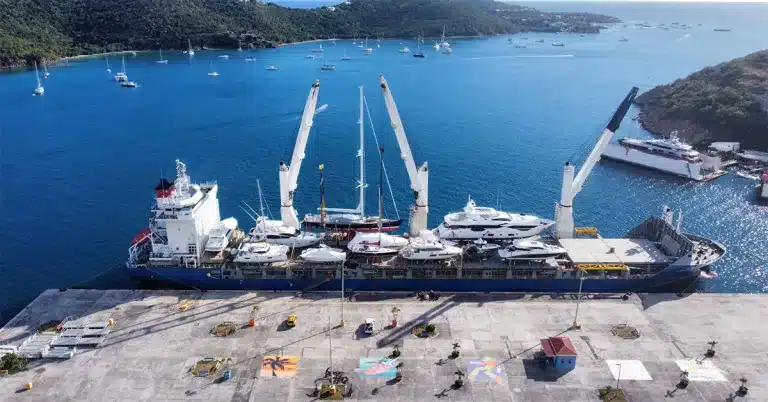Comparing Transport Options: Tanker vs Hauling Marine Vessel
Have trouble deciding how to move your prized yacht from A to B? You’re not alone.
Choosing between tanker transport and hauling marine vessels can feel like navigating uncharted waters. Which is safer? More efficient?
In this Tanker vs Hauling Marine Vessel guide, we’ll toss a lifeline by delving into both methods—tanker transport with its robustness and sea-faring charm, against the versatility and convenience of hauling marine vessels.
You’ll get insight on how each process works—the good, the bad—and even practical tips on prepping your yacht for shipping. By the journey’s end, you’ll have navigated through real-world examples that will help chart out clear sailing ahead.
Weigh anchor! An enlightening voyage awaits…
Understanding Yacht Shipping
Yacht shipping, a crucial part of the maritime industry, involves moving these luxurious vessels from one location to another. This process is vital for yacht owners who want their prized possessions delivered safely and efficiently.
The concept of yacht shipping might seem simple on the surface: pick up the boat here, drop it off there. However, in reality, the process is much more intricate.
Marine Link, an authoritative source in marine news, gives us a peek into this intricate world. They describe how yacht transport professionals must handle logistics like custom regulations and weather conditions while ensuring the yachts remain undamaged during transit.
In North America, two primary methods of sea freight are commonly used for yacht transport in North America – tanker transport and hauling via marine vessels. Yacht owners must contemplate the pluses and minuses of each approach before settling on a choice.
Tanker transport often uses semi-submersible ships that can partially submerge to allow yachts to float on or off at port. On the other hand, hauling involves lifting yachts onto specialized cargo ships using large cranes.
Your choice between these two depends largely on cost efficiency, safety measures offered by each option, and personal preferences about handling your luxury asset during transit.
When exploring a yacht transportation shipping mode, it’s paramount to exclude freight and container ship freighters from consideration, focusing instead on methods tailored for oversized and specialized cargo. In this context, assessing alternatives like rail freight, cruise ships, barge transportation, and multimodal transport becomes even more crucial, as these avenues are better equipped to accommodate the unique maritime transport requirements of yacht shipping.
Factors such as ship speed and the ability to handle full container loads should be carefully weighed to ensure these high-value maritime assets’ safe and efficient transport.
An Overview of Tanker Transport Container Ships for Yachts

Shipping a yacht via tanker offers several benefits. These massive ships can carry multiple yachts, making it an efficient choice.
The process starts when the yacht is carefully lifted onto the deck with specialized cranes. The crew then secures your prized possession in a custom-built cradle to ensure it stays safe during transit.
This method of ocean freight is ideal for moving large or heavy yachts over long distances because tankers have plenty of space and sturdy structures. They also operate on set schedules, offering predictability for delivery times.
This type of transportation can be ideal for transporting your boat to events like the Fort Lauderdale International Boat Show (FLIBS). High-end luxury yachts from all over the world need to be securely transported to ensure they arrive at FLIBS in ship shape!
However, there may be certain drawbacks to consider. For instance, timing can be tricky as tankers work on tight schedules, and any delay might mean waiting for the next available slot.
Advantages of Using Tanker Transport
- Tankers can handle large loads – perfect for big boats.
- A predictable schedule means less guesswork around arrival times.
- The strong structure provides added security during transit.
An In-depth Look at Hauling Marine Vessels for Yacht Shipping
Shipping yachts via hauling marine vessels is a popular method. This technique involves loading the yacht onto a barge or specialized ship that carries other ships.
The Procedure of Hauling
First, your yacht gets lifted from the water by powerful cranes and placed securely on the deck of a larger vessel. It’s then fastened with straps and braces to stay put during ocean transit.
This procedure allows us to transport multiple yachts simultaneously, reducing costs and improving efficiency. Careful consideration must be taken when organizing this intricate process.
Benefits & Disadvantages
Hauling has notable benefits, such as cost-effectiveness when shipping multiple yachts together and flexible routes since large vessels can access many ports worldwide.
In contrast, there are potential downsides like possible damage during lifting or securing procedures despite taking all precautions. Also, longer delivery times could be an issue if you’re pressed for time because haulers don’t move as swiftly as tankers.
Remember: understanding each aspect will help you choose wisely between tanker transport or hauling marine vessels for your precious cargo.
Tanker Transport vs. Hauling Marine Vessels vs. Air Freight Transportation
The two most popular yacht shipping methods are tanker transport and hauling marine vessels. Both methods possess their benefits and possible disadvantages. On the other hand, air freight transportation is impossible for most boats, especially yachts, because they are too large and weigh too much.
Tanker Transport for Yachts
Tanker transport is often preferred for its efficiency. It can easily accommodate larger yachts, reducing concerns about size limitations that might occur with other options. But there’s more to consider than just size; cost also comes into play.
The process involves floating the yacht onto a semi-submersible vessel, which carries it to its destination. The convenience of this method is unparalleled, but so can the shipping costs associated.
Hauling Marine Vessels for Yacht Shipping
On the other hand, hauling marine vessels uses specialized trailers to carry your prized possession over land or sea routes physically.
This approach offers an economical alternative suited to smaller yachts or shorter distances. Although cheaper, it may not always be practical due to infrastructure constraints such as road width or bridge heights along transportation routes.
- Economical: This option costs less than tanker transport, especially over short distances.
- Versatile: Capable of handling various sizes of boats up to a certain limit, depending on trailer capacity.
- Limited by Infrastructure: Road widths and bridge heights can impact feasibility when moving large boats overland using this method.
Preparing Your Yacht for Shipping
Safeguarding your yacht during transit starts with a thorough cleanup. Remove all personal items and secure loose gear on deck. The same goes for detachable equipment like antennas, radars, or flagpoles.
Proper preparation can prevent damage to these sensitive parts. For extra protection, consider shrink-wrapping the entire vessel.
Fuel tanks should be less than half full but not completely empty. This balance prevents spills and leaves enough fuel to move the boat to its destination port if needed.
Don’t forget about winterizing. If shipping occurs during colder months or into colder climates, winterization is crucial.
You also need insurance coverage tailored to transport risks. Regular policies might not cover damages that occur during transit, so it’s worth asking your provider about additional options before you ship.
Maintaining Communication During Transit
Your involvement doesn’t end once your yacht boards a tanker or a marine hauling vessel – regular updates are also key.
Establishing good communication channels with the transporter will let you track progress throughout the journey and react promptly if anything unexpected happens.
The Final Checkup Before Departure
- A detailed inspection just before departure helps spot any overlooked issues.
- Make sure all hatches are securely closed and sealed to prevent water intrusion.
- Double-check the yacht’s cradle for proper alignment and stability. This final step is key to a safe journey.
With these steps, you’ll know your prized possession is ready for its voyage across the sea or country. Happy shipping.
Case Studies of Yacht Shipping
The practical application of tanker transport and hauling marine vessels for yacht shipping is best illustrated through real-world examples. Let’s examine two such case studies.
Tanker Transport: The Story of the ‘Sea Dream’
In 2023, a high-end luxury yacht named ‘Sea Dream’ must be transported from Miami to Barcelona. The owners opted for tanker transport, considering its safety features, weight, and ability to handle larger yachts.
The journey was smooth, with the vessel arriving on time and in perfect condition. This example showcases how tanker transport can provide secure transits even across long distances.
Hauling Marine Vessel: Case of the ‘Sunseeker Predator’
A contrasting scenario unfolded when a mid-sized Sunseeker Predator required shipping from Fort Lauderdale to Sydney in late 2023. Due to size constraints, hauling marine vessels made more sense economically and logistically.
This method allowed direct delivery at an Australian port closer to any available deep-water ports suitable for tankers. Thus proving that smaller yachts could benefit significantly from this option because it offers flexibility without compromising security or timeliness.
Making the Right Choice for Your Yacht Shipping Needs
Choosing between tanker transport and hauling marine vessels isn’t always easy. Each option has its merits but also potential drawbacks. To make an informed decision, you should factor in your yacht’s size, destination, and budget to determine which option is best.
The cost of sea transport can differ depending on the selected option. Yachting World notes that using tankers is often more affordable for larger yachts due to their high carrying capacity. However, hauling might be better if your yacht is smaller or medium-sized because it allows more flexibility in routes and destinations.
Safety should also play an essential role in your choice. As detailed by the Maritime Executive, both methods have proven safety records when handled correctly by experienced professionals.
- Tanker transports use stabilization systems to keep yachts secure during transit.
- Hauling marine vessels provide custom cradles for each yacht’s unique specifications.
- Both options ensure optimal protection against sea conditions and weather changes throughout the journey.
Your final decision will hinge on balancing these considerations with what best suits your needs and circumstances.
FAQs – Comparing Transport Options for Yacht Shipping: Tanker vs Hauling Marine Vessel
How are yachts transported?
Yachts can be shipped using tankers or hauling marine vessels. The choice depends on factors like size, destination, cargo capacity, and budget.
What’s the difference between a ship and a yacht?
A ship is generally larger than a yacht. Yachts are often used for pleasure or racing, while ships usually carry a load of cargo or passengers over long distances.
How much does it cost to ship a yacht?
The price varies considerably based on transport method, distance traveled, and yacht size. It could range from thousands to hundreds of thousands of dollars.
What size boat is considered a yacht?
A boat typically becomes classified as a ‘yacht’ when it surpasses 33 feet in length. But remember, this classification isn’t strict – other features play roles too.
Conclusion
So, you’ve journeyed through the complexities of yacht shipping. By now, the fog should be lifting.
You’ve learned about tanker transport and hauling marine vessels—each with its merits and drawbacks.
Tanker transport offers robustness but might strain your wallet more. Conversely, hauling marine vessels brings versatility and can often prove a cost-effective alternative.
Preparing your yacht for shipping is key, too. Make sure it’s ready to weather any storm during transit.
Real-world examples have painted vivid pictures of both methods in action—providing practical insight into what works best under different circumstances.
Cross Chartering Yacht Transport is your trusted partner for global yacht transport, shipping, and delivery to North America, the Mediterranean, and Asia.
